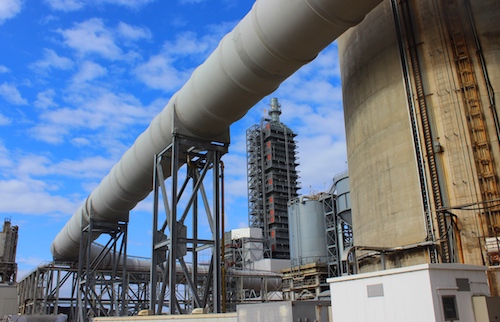A newly released federal report about the state of the electricity generation industry blames not environmental regulations but the low cost of natural gas for the closure of coal and nuclear plants.
The electricity generation market has been radically transformed in the last 15 years. The demand for coal peaked in 2007. Thousands of megawatts of 24-hour a day, seven-days a week coal and nuclear power plants have been shut down, taking tens of thousands of, often union, jobs with them.
Utilities have been replacing them with solar, wind and most frequently, natural gas fueled peaker plants made possible by the fracking boom.
The new generation is often in different places –most coal powerhouse closures have been in Appalachia and the Midwest; most new solar capacity is being built in the deserts of California and Nevada.
And as fuel source changes, so does the number and quality of the jobs needed to build and run it. Intermittent resources, such as, photovoltaic panels or rooftop solar, has a higher per megawatt cost, and employs up to 90 percent fewer workers than an equivalent natural gas plant, and the jobs are low skill and lower wage. In contrast, the electric power industry directly employs nearly 2.7 million jobs and provides employees a living-wage that’s almost double the national average, many of which are union jobs.

|
The report urges federal agencies to make it easier for older coal plants to install carbon scrubbing technology as an intermediate step while clean coal technology -- like that used at the Petra Nova plant in Texas -- matures.
Photo courtesy NRG.
|
Despite these changes, the federal regulations governing this $800 billion industry have not changed in decades. The 187-page Department of Energy report, released Aug. 23, is a statement of intent by the Trump administration about the energy reform it intends to pursue.
“It is apparent that in today’s competitive markets certain regulations and subsidies are having a large impact on the functioning of markets, and thereby challenging our power generation mix. It is important for policy makers to consider their intended and unintended effects,” wrote Energy Secretary Rick Perry in the introduction.
The IBEW has been lobbying for reform of the energy market for decades, said Utility Department Director Donnie Colston. The report, he says, is a good first step.
“This is encouraging. But these ideas are not new, and unless these reforms are translated into action we will watch more plants close and reliability suffer,” Colston said.
The report called for at least three changes to federal regulation to maintain grid reliability in the years ahead, reforms that align with the IBEW’s priorities.
First, the report urges the Environmental Protection Agency to ease rules that make it difficult to retrofit older coal powerhouses with equipment that would remove carbon dioxide -- the major cause of global climate change—from smoke stack emissions. The cost and inevitable delays caused by compliance with the regulations “create an unnecessary burden that discourages rather than encourages installation of C02 emission control equipment and investments in efficiency.”
Second, the report addresses a market failure that allows solar and wind to thrive at the expense of nuclear and coal, yet still relies on these baseload generators to meet consumer demand.
Currently, independent grid operators buy from whatever power generator is cheapest. On some days, wind and solar companies can sell power for nothing –give it away-- and still make money because of federal and state subsidies. That would be great for consumers if they could do it all the time, but every night and on many days, winds drop and the sun sets or is blocked by clouds.
Customers still need power; the kind baseload generators have delivered for more than a century. But many hundreds of them simply didn’t make enough money on those days to stay in business, and many hundreds more are facing closure in the next decade, taking tens of thousands of jobs.
The report encourages the Federal Energy Regulatory Commission and the North American Electric Reliability Corporation to reform how prices are set and give a greater economic return to electricity providers that ensure unbroken service, while broadening resilience planning and performance.
The report also calls for the Nuclear Regulatory Commission to improve the decades long permitting process for new nuclear plants which has slowed the construction of the plants that provide carbon-free, baseload power source to a near standstill.
“America is also fortunate to have a variety of fuel sources. We need to consider how to use each effectively while recognizing our differences and unique state and regional circumstances,” Perry wrote. “We also need to recognize the relationship between resiliency and the price of energy. Customers should know that a resilient electric grid does come with a price.”
The result of reforms like these would be to strengthen one of the IBEW’s most important industries and keep reliability as its primary mission. The Electrical Worker is investigating the changing energy markets, their effect on grid reliability and impact on IBEW members. Look for an article soon, in the Electrical Worker newspaper and online.
Perry commissioned the report in April to align federal rules with the evolution of electricity generation in recent years. Last year, for example, for the first time in history, natural gas replaced coal as the leading source of electricity generation. In 2015, a record-high amount of generating capacity retired, and while, over the last decade, growth in national electricity consumption has been flat, natural gas, wind, and solar have repeatedly increased their percentage of total production.
“There’s no standing in the way of technology,” Colston said. “What we want, and what Secretary Perry said he wants too, is that the U.S. prioritizes reliability, resilience, affordability and fuel diversity. It is all we have ever asked for because it will be best for customers and for our members.”